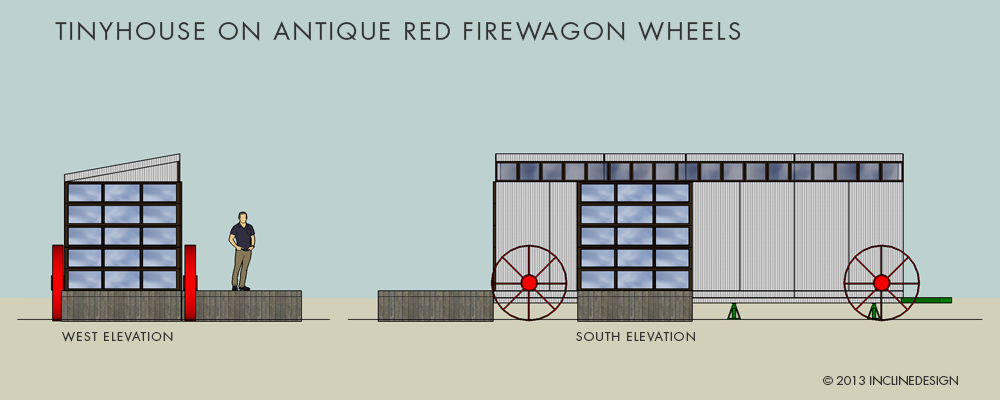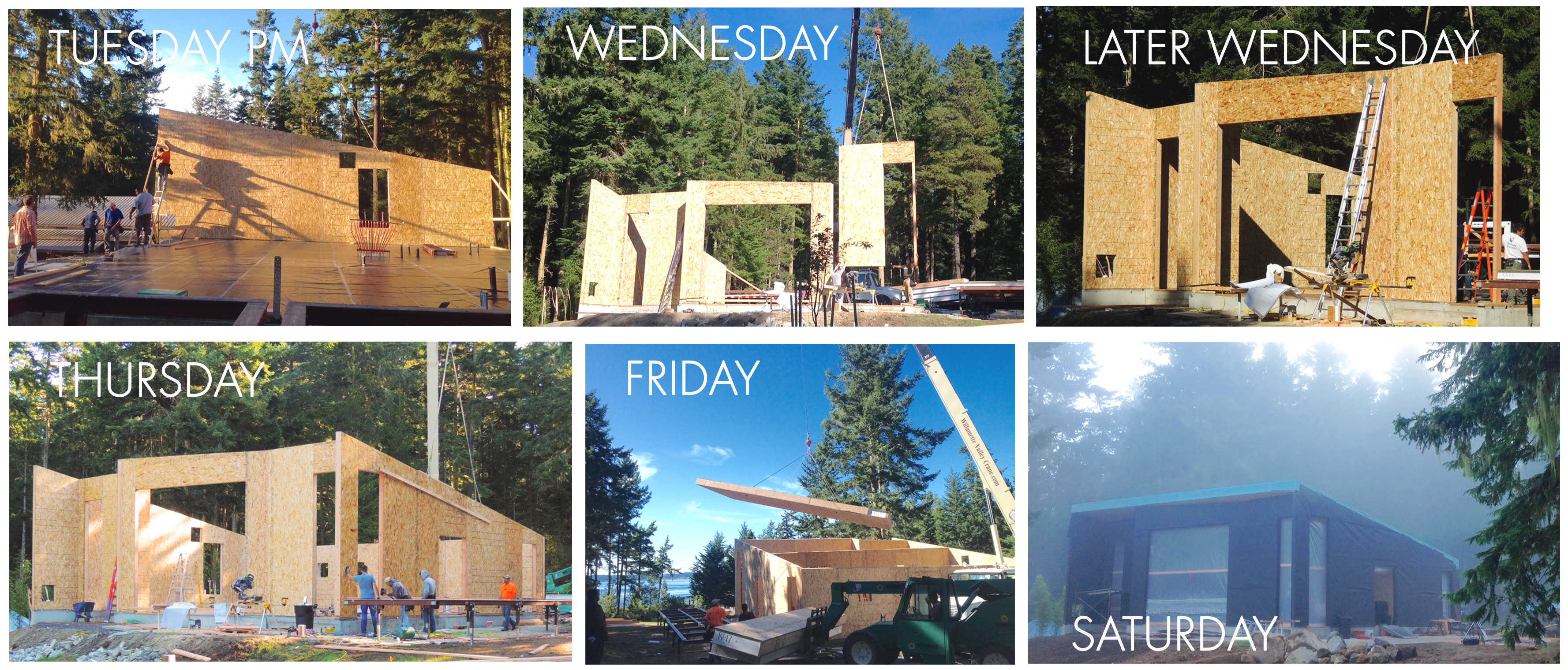Congratulations, you’ve found your dream building site! Now you’re looking for a cost effective way to build your house, and comparing (or trying to) the costs of building a custom architect-designed home, to the multitude of template plans for prefab, kit, or modular houses. Well, we’ve also gone through that comparison process, and were not really satisfied with what we found……so we have come up with our own streamlined hybrid building process, which might be an affordable option for you. Our process considers the best of custom design, plus applies a prefab mindset, to get the best bang for the buck!
It all started as a kind of joke, but it got us thinking about designing a house with an affordable streamlined building process. We live part time in the San Juan Islands, and we fantasized about picking up a purpose-built 30’ trailer fabricated in Olympia Washington for a Tiny House project, then towing it behind our monster diesel dually Ford 350 truck to Premier SIPs in Fife (Washington). Here we have Premier load our pre-designed, prefabricated floor, walls and roof panels, along with all the necessary adhesives, screws and nails onto the trailer. Next door to Premier we pick up a couple of roll-up garage-style doors from NW Door, before heading up to Kent, where we add the entire list of flat-pack kitchen, bathroom and bedroom cabinet components from IKEA. Next stop, a Taylor Metal Roofing distributor for roof and siding panels, and then north to Skagit Salvage in Mt. Vernon for some of the missing windows, interior doors, reclaimed wood floor and trim, and other missing items…..and don’t forget the red wheels! Our initial “fun” concept ~ see below

Finally (sigh) we are on the ferry with a fully loaded truck & trailer headed for the San Juans (over-height and over-length WSF ferry fees no joke) but hey,we have it all in a neat plug and play package! We’ll be able to assemble everything, and move into our new Tiny House by the weekend!…….well, realistically that’ll be more like in a couple of weeks, if the local crew including electrician and plumber show up on time! Unless you are building modular with almost complete electrical and plumbing already in place on delivery to the site, you encounter the same issues as you do with a custom home, especially in remote (island) locations.
So how do we take this ”Tiny House-on-a-trailer” concept and replicate the process for a 2000 sf or more custom designed house? Every process has its stigma: custom means expensive, and flat-packed or prefab has a different kind of stigma…though of course there are many very well designed prefab houses. These prefabs (though they claim the opposite) are very often not quite as affordable as you might wish! Or you are not getting the consistent quality of product for the entire package you think you are getting! Just start trying to compare apples to apples of what’s included, then think about adding the factory overhead, or costs for changes to standard plans and custom features, or hidden architects fees, then of course the GC’s % for the actual build!
Every design we do is a custom design, and as part of our strategy it includes a streamlined hybrid build process as an integral part of the design. What makes sense to factory-build offsite is the building envelope, with high R-rated panelized walls, roof and even floors, all of which are structural; meaning inclusive of structural elements such as floor joists, posts, beams, headers and roof trusses built into a Structural Insulated Panel (SIP) along with rigid insulation. SIPs are such a great solution that multi-million dollar custom homes are using SIP’s, for many of the same reasons we do: cost-efficient build process, high R-value envelope, ‘green’ considerations.
SIPs save time and money on site as you are building the exterior wall face, insulating the wall with rigid insulation, and doing the interior wall face all at once. It’s an “insulated“ sandwich, and a very effective one at that, and it all results in a very tight, energy-efficient ‘green’ house.
Permits in hand, when we are ready to build we schedule the initial delivery to include the building envelope elements of the house, which can be assembled really fast even in a remote location. Windows have arrived onsite as complete and framed units, ready for installation in the pre-cut openings after the SIPs have been assembled (floor, roof and walls), then the house and roof are wrapped (see Saturday image below). The metal roof, and gutter installation might even be scheduled in the same time frame as the windows, depending on access and trades. With good pre-planning, and cooperation from all involved, the finished building envelope really can all be accomplished in 10 days or less!

Now comes the tricky part, and impeccable planning by the designers for the electrical and plumbing is key. We design these elements knowing the obstacles that must be overcome in a SIPS house (or any house for that matter), for installing an HRV system (Heat Recovery Ventilation system), which we foresee will soon be required in all tight houses. ”Time is Money” is more than ever true in designing a house for efficient ventilation, heating, wiring and plumbing runs that can save the trades time, and you the client, money. We consult with subject experts early in the planning stage to insure the plans include the necessary guidelines for efficient implementation. The mechanical and electrical infrastructure should be clearly called out, and not left to the GC to figure out during the build, as often happens. We have seen horror stories where architects or designers have not taken into account the mechanical infrastructure of a custom home design, leading to considerable added expense of changes and redo’s during the build process.
With the rough plumbing and electrical complete, the exterior finish (siding and deck), and interior finish components can be delivered and staged in an appropriate location(s) on site. It’s not always possible to have these all delivered at the same time when not doing a kit house, but impeccable scheduling can have all custom components required for the finish work on site in a timely manner.
We actively promote an on-going dialog between the GC, designer and structural engineer throughout the design and build process, which results in fast answers and quick solutions when and if required. The GC and or designer’s team of trades showing up on time, understanding the project and what is required of them, can impact the bottom line very quickly either way. This is true of a custom house or a kit house. So when the prefab kit salesman claims fixed cost as an advantage, it may be fixed materials cost, but the “labor” costs can become a moving target on any project if not managed closely.
How fast to the finish line will of course depend on the scheduling and reliability of the trades, and the amount of available man (or woman)-power. I recently read about a 5500 sf SIP house where after the SIP walls were up (7 days), and the building envelope complete (another 5 days), 7 (!) electricians showed up under a lead electrician, and worked for 3 full days to complete the electrical rough-in on the project. My experience is that resources are not often available like this.
On the inside, IKEA flat-pack components have a stigma in some circles, however if affordability is key, then IKEA interior components are an excellent way to be cost effective, and they can be customized (with some added expense of course) to meet the most stringent design criteria! We know, we’ve done it! Take a look at our red kitchen. If your budget and inclination is for a custom product we can design the mill-work and have it fabricated, delivered and installed by a local vendor or even delivered as a complete package from Europe!
Some factory-built items, some hand-crafted customized components, all designed to make up a one-of-a-kind custom home, coupled with a streamlined hybrid building process just might be the affordable option you are looking for! Check us out
James Ferris, Principal and lead designer @ INCLINEDESIGN.
